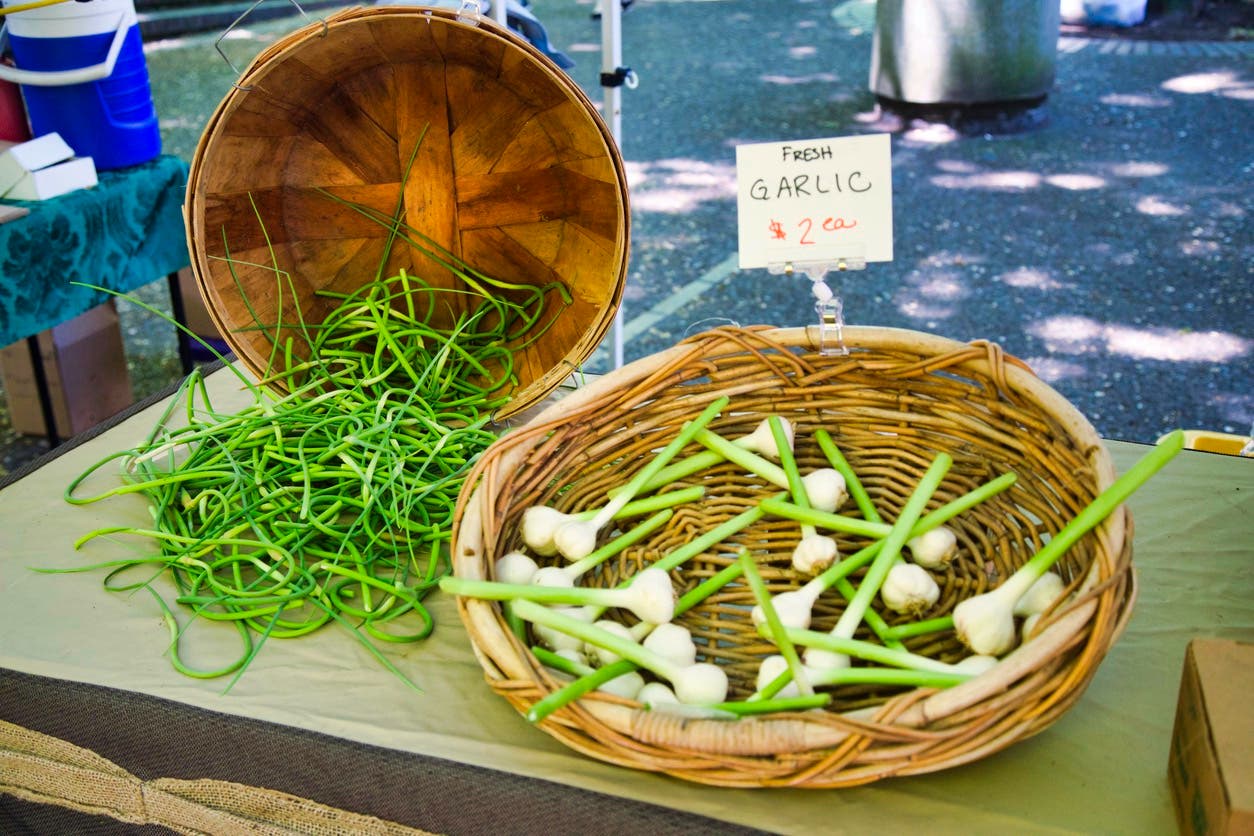
Green Garlic, Garlic Scapes, Ramps—What’s the Difference?!
Three cheers for the bright, garlicky greens of spring! Green garlic, garlic scapes, and ramps (aka wild garlic) may just be the most versatile greens you can find at the farmers market once the weather warms up—and they’re certainly the most aromatic! Here’s how, when, and where to shop for the different types of garlic, plus all the ways to use them when you bring a bunch home.
Green Garlic vs. Garlic Scapes
Green garlic and garlic scapes are two different vegetables that come from the same plant grown to produce dried garlic bulbs. Both are delicious byproducts of growing garlic that are now cultivated in their own right.



This Week Only!
Save 40% on Forks Meal Planner
Healthy eating has never been so easy.
Green Garlic
Green garlic is young garlic harvested in early spring when the plants are still immature and green. The stalks look like miniature leeks, with a white base, flat, firm green leaves, and a telltale pink blush near the bulb end. Originally harvested because growers needed to thin out garlic plants so they’d develop properly, stalks of green garlic are now a highly sought-after produce item.
Taste
Green garlic tastes like a cross between a leek and a green onion, with a hint of garlicky pungency.
Availability
Green garlic is available in early spring, one of the first aromatic greens to appear as the weather starts to warm up.
Shopping and Storage
Look for green garlic that is vibrant green and tender with no browning. It will keep up to two weeks in the fridge, stored in a breathable bag or container in the crisper drawer. We don't recommend freezing green garlic: The icy temperatures can make their stalks soggy and also cause their flavor compounds to turn bitter.
How to Prepare Green Garlic
To prep green garlic, rinse it well, trim away the root end and any yellowing leaves, then cut or chop the rest as you would scallions.
Garlic Scapes
Garlic scapes are the flower stems that develop on garlic plants in late spring and early summer, once the bulbs have matured. They’re trimmed before they bloom, so that all the plants’ energy goes to forming plump, fully mature heads of garlic.
Garlic scapes can be curly or straight, and their pointy bulbs near the tips make them hard to mistake for anything else. Because the stems are round and thick, they can be grilled, sautéed, stir-fried, and pickled just like green beans.
Taste
Garlic scapes have a garlicky chive flavor, with a hint of green bean sweetness.
Availability
Garlic scapes are available in late spring/early summer.
Shopping and Storage
Look for garlic scapes that are vibrant green and tender with no browning. Garlic scapes will keep up to two weeks in the fridge, stored in a breathable bag or container in the crisper drawer. We don't recommend freezing them: The icy temperatures can make them soggy and also cause their flavor compounds to turn bitter.
How to Prepare Garlic Scapes
To prep garlic scapes, trim base ends, then chop or cut into longer pieces. Scape bulbs are edible but can be fibrous, so they may need to be trimmed as well.
What About Ramps (Wild Garlic)?
Ramps—aka wild garlic, wild leeks, or spring onions—are another garlic-flavored plant found in the spring. The broad-leafed, red-stemmed bulbs are members of the allium (onion/garlic) family that grow wild up and down the U.S. Eastern Seaboard. They are also increasingly grown commercially and by home gardeners in shady areas with loamy soil. Like other leafy greens, ramps should be stored in a breathable bag or container in the crisper drawer of the fridge.
Taste
Ramps/wild garlic taste pungent and garlicky, but without dried garlic’s fiery bite.
Availability
Ramps/wild garlic are available throughout the spring.
How to Prepare Ramps
To prep ramps, rinse them well, trim the bulb end, then chop the rest—bulb, stem, and leaves. If the leaves look wilted, soak the ramps in a cold-water bath for 10 to 15 minutes to perk them up.
5 Easy Ways to Try Green Garlic, Garlic Scapes, and Ramps
Each of the three spring garlic types has its own, distinctive look and taste, and each appears at different times throughout the spring. They can be used interchangeably, however, so if you can’t find one that’s called for in a given recipe, you can usually swap in another. Here are five easy ways to start using them and make the most of their very short season.
1. Any recipe that calls for green onions
That’s right. You can use green garlic, garlic scapes, or ramps as a 1:1 substitution for green onions. How simple is that? (It’s also an excellent way to familiarize yourself with their flavor.)
2. Pesto
Pesto is probably the most popular way to use ramps, and pesto recipes also work well with green garlic and garlic scapes. Try them in place of basil in a Homemade Vegan Pesto (omit the garlic cloves) or our Pesto Artichoke Spread. Note: Pesto is probably the best way to use up and preserve the garlicky greens, because it can be stored in the fridge for two weeks or frozen for up to six months.
3. As a cilantro substitute in salsa and other recipes
Don’t love cilantro? Try swapping in an equal amount of green garlic, garlic scapes, or ramps, which all lend a similar bright, crisp accent. They work especially great in salsa, as their pungent flavor compounds stand up to the bold, spicy ingredients.
4. Stir-fries
Green garlic and garlic scapes are a favorite springtime ingredient in Asian cuisines, where they add incredible texture and flavor to stir-fry recipes. To get started, coarsely chop enough green garlic, garlic scapes, or ramps into 1-inch lengths to make 1 cup, then add them along with the other vegetables in our recipe for Stir-Fried Veggies and Noodles.
5. Salads
Prep green garlic, scapes, or ramps according to the directions above; then toss with mixed greens before making a salad.
To learn delicious vegan recipes and master whole-food, plant-based culinary techniques at home, check out Forks Over Knives Cooking Courses!
About the Author

About the Author
Mary Margaret Chappell
Join our mailing list
Get free recipes and the latest info on living a happy, healthy plant-based lifestyle.
By providing your email address, you consent to receive newsletter emails from Forks Over Knives. We value your privacy and will keep your email address safe. You may unsubscribe from our emails at any time.
